Litter (vehicle)
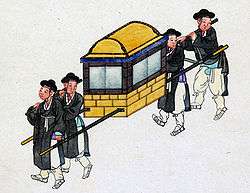
.jpg)
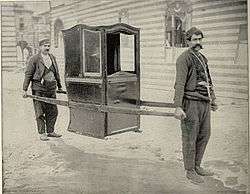
The litter is a class of wheelless vehicles, a type of human-powered transport, for the transport of persons. Examples of litter vehicles include palki or पालकी (Bangladesh, Ghana and India), lectica (ancient Rome), kiệu [轎] (Vietnam), sedan chair (Britain), litera (Spain), palanquin (France, India), jiao (China), liteira (Portugal), wo (วอ, Chinese style known as kiao เกี้ยว) (Thailand), gama (Korea), koshi, ren and kago (Japan), tahtırevan (Turkey) and sankayan (Philippines)
Smaller litters may take the form of open chairs or beds carried by two or more carriers, some being enclosed for protection from the elements. Larger litters, for example in ancient India, Queens would travel in quite spacious palanquin with facility to sleep if travelling long journey and with availability of eatables and other necessities. Those of the Chinese emperors, may resemble small rooms upon a platform borne upon the shoulders of a dozen or more people. To most efficiently carry a litter, porters will attempt to transfer the load to their shoulders, either by placing the carrying poles upon their shoulders, or the use of a yoke to transfer the load from the carrying poles to the shoulder.
Definitions

A simple litter, often called a king carrier, consists of a sling attached along its length to poles or stretched inside a frame. The poles or frame are carried by porters in front and behind. Such simple litters are common on battlefields and emergency situations, where terrain prohibits wheeled vehicles from carrying away the dead and wounded.
Litters can also be created by the expedient of the lashing of poles to a chair. Such litters, consisting of a simple cane chair with maybe an umbrella to ward off the elements and two stout bamboo poles, may still be found in Chinese mountain resorts such as the Huangshan Mountains to carry tourists along scenic paths and to viewing positions inaccessible by other means of transport.
A more luxurious version consists of a bed or couch, sometimes enclosed by curtains, for the passenger or passengers to lie on. These are carried by at least two porters in equal numbers in front and behind, using wooden rails that pass through brackets on the sides of the couch. The largest and heaviest types would be carried by draught animals.
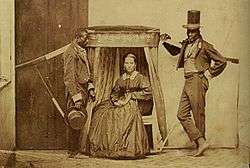
Another form, commonly called a sedan chair, consists of a chair or windowed cabin suitable for a single occupant, also carried by at least two porters in front and behind, using wooden rails that pass through brackets on the sides of the chair. These porters were known in London as "chairmen". These have been very rare since the 19th century, but such enclosed portable litters have been used as an elite form of transport for centuries, especially in cultures where women are kept secluded.
Sedan chairs, in use until the 19th century, were accompanied at night by link-boys who carried torches.[2] Where possible, the link boys escorted the fares to the chairmen, the passengers then being delivered to the door of their lodgings.[2] Several houses in Bath, Somerset, England still have the link extinguishers on the exteriors, shaped like outsized candle snuffers[2] (photo). In the 1970s, entrepreneur and Bathwick resident, John Cuningham, revived the sedan chair service business for a brief amount of time.[2]
Antiquity
In pharaonic Egypt and many oriental realms such as India and China, the ruler and divinities (in the form of an idol like lord Krishna) were often transported in a litter in public, frequently in procession, as during state ceremonial or religious festivals.
The ancient Hebrews fashioned the Ark of the Covenant to resemble and function as a litter for the ten commandments and presence of God.
In Ancient Rome, a litter called lectica or "sella" often carried members of the imperial family, as well as other dignitaries and other members of the rich elite, when not mounted on horseback.
The habit must have proven quite persistent, for the Third Council of Braga in 675 AD saw the need to order that bishops, when carrying the relics of martyrs in procession, must walk to the church, and not be carried in a chair, or litter, by deacons clothed in white.
In the Catholic Church, Popes were carried the same way in Sedia gestatoria, which was replaced later by the Popemobile.
In Asia
India
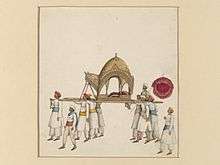
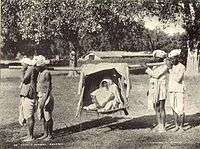
A Palanquin (Palki) is a covered sedan chair (or litter) carried on four poles. It derives from the Sanskrit word for a bed or couch, pa:lanka.
Palanquins are mentioned in literature as early as the Ramayana (c. 250BC).
Palanquins began to fall out of use after rickshaws (on wheels, more practical) were introduced in the 1930s.
The doli (also transliterated from Hindi as dhooly or dhoolie) is a cot or frame, suspended by the four corners from a bamboo pole. Two or four men would carry it. In the time of the British in India, dhooly-bearers were used to carry the wounded from the battlefield and transport them.
Today in numerous areas of India including at the Hindu pilgrimage site of Amarnath Temple in Kashmir, palanquins can be hired to carry the customer up steep hills.
In weddings, Doli is used to carry Brides, while Palki is used by Grooms.
China
In Han China the elite travelled in light bamboo seats supported on a carrier's back like a backpack. In the Northern Wei Dynasty and the Northern and Southern Song Dynasties, wooden carriages on poles appear in painted landscape scrolls.
A commoner used a wooden or bamboo civil litter (Chinese: 民轎; pinyin: min2 jiao4), while the mandarin class used an official litter (Chinese: 官轎; pinyin: guan1 jiao4) enclosed in silk curtains.
The chair with perhaps the greatest importance was the bridal chair. A traditional bride is carried to her wedding ceremony by a "shoulder carriage" (Chinese: 肩輿; pinyin: jiān yú), usually hired. These were lacquered in an auspicious shade of red, richly ornamented and gilded, and were equipped with red silk curtains to screen the bride from onlookers.[3]
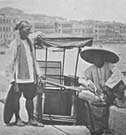
Sedan chairs were once the only public conveyance in Hong Kong, filling the role of cabs. Chair stands were found at all hotels, wharves, and major crossroads. Public chairs were licensed, and charged according to tariffs which would be displayed inside.[3] Private chairs were an important marker of a person's status. Civil officers' status was denoted by the number of bearers attached to his chair.[3] Before Hong Kong's Peak Tram went into service in 1888, wealthy residents of The Peak were carried on sedan chairs by coolies up the steep paths to their residence including Sir Richard MacDonnell's (former Governor of Hong Kong) summer home, where they could take advantage of the cooler climate. Since 1975 an annual sedan chair race has been held to benefit the Matilda International Hospital and commemorate the practice of earlier days.
Korea
In Korea, royalty and aristocrats were carried in wooden litters called gama. Gamas were primarily used by royalty and government officials. There were six types of gama, each assigned to different government official rankings. In traditional weddings, the bride and groom are carried to the ceremony in separate gamas. Because of the difficulties posed by the mountainous terrain of the Korean peninsula and the lack of paved roads, gamas were preferred over wheeled vehicles.
Japan
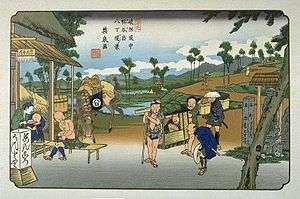
As the population of Japan increased, less and less land was available as grazing for the upkeep of horses. With the availability of horses restricted to martial uses, human powered transport became more important and prevalent.
Kago (Kanji: 駕籠, Hiragana: かご) were often used in Japan to transport the non-samurai citizen. Norimono were used by the warrior class and nobility, most famously during the Tokugawa period when regional samurai were required to spend a part of the year in Edo (Tokyo) with their families, resulting in yearly migrations of the rich and powerful (Sankin-kōtai) to and from the capital along the central backbone road of Japan.
Somewhat similar in appearance to kago are the portable shrines that are used to carry the "god-body" (goshintai), the central totemic core normally found in the most sacred area of Shinto Shrines, on a tour to and from a shrine during some religious festivals.
Vietnam
Traditional Vietnam employed two distinct types of litters, the cáng and the kiệu. The cáng is a basic bamboo pole with the rider reclining in a hammock. More elaborate cáng had an adjustable woven bamboo shade to shelter the occupant. Dignitaries would have an entourage to carry parasols.
The kiệu resemble more of the sedan chair, enclosed with a fixed elaborately carved roof and doors. While the cáng has become obsolete, the kiệu is retained in certain traditional rituals a part of a temple devotional procession.
Thailand
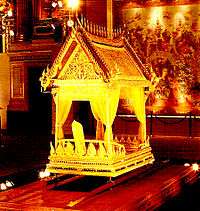
In Thailand, the royalty were also carried in wooden litters called wo ("พระวอ" Phra Wo, literally, "Royal Sedan") for large ceremonies. Wos were elaborately decorated litters that were delicately carved and colored by gold leaves. Stained glass is also used to decorate the litters. Presently, Royal Wos and carriages are only used for royal ceremonies in Thailand. They are exhibited in the Bangkok National Museum.
Indonesia
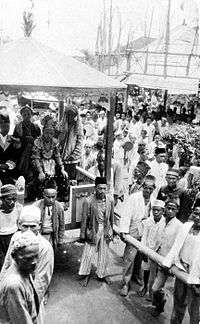
In traditional Javanese society, the generic palanquin or joli was a wicker chair with a canopy, attached to two poles, and borne on men's shoulders, and was available for hire to any paying customer.[4] As a status marker, gilded throne-like palanquins, or jempana, were originally reserved solely for royalty, and later co-opted by the Dutch, as a status marker: the more elaborate the palanquin, the higher the status of the owner. The joli was transported either by hired help, by nobles' peasants, or by slaves.
Historically, the palanquin of a Javanese king (raja), prince (pangeran), lord (raden mas) or other noble (bangsawan) was known as a jempana; a more throne-like version was called a pangkem. It was always part of a large military procession, with a yellow (the Javanese colour for royalty) square canopy. The ceremonial parasol (payung) was held above the palanquin, which was carried by a bearer behind and flanked by the most loyal bodyguards, usually about 12 men, with pikes, sabres, lances, muskets, keris and a variety of disguised blades. In contrast, the canopy of the Sumatran palanquin was oval-shaped and draped in white cloth; this was reflective of greater cultural permeation by Islam.[5] Occasionally, a weapon or heirloom, such as an important keris or tombak, was given its own palanquin. In Hindu culture in Bali today, the tradition of using palanquins for auspicious statues, weapons or heirlooms continues, for funerals especially; in more elaborate rituals, a palanquin is used to bear the body, and is subsequently cremated along with the departed.
Philippines
In pre-colonial Philippines it is a way of transportation of the elite; sovereign princes or Datu's and their wives use Sankayan/Sakayan a wooden or bamboo throne called with elaborate and intricate carvings carried by their slaves usually accompanied by umbrella bearers. There are special of princes and princesses who are secluded, well-guarded and well-kept called binukot/binocot who are not allowed to walk on soil, instead when they need to go anywhere they are veiled and carried in a hammock or in a basket that is similar to a birds nest carried by their slaves, and when they need to travel far they are carried inside larger covered palanquins with silk covers, other are miniature versions of a hut.
In Africa
Ghana

In Southern Ghana the Akan and the Ga-Dangme carry their chiefs and kings in palanquins when they appear in their state durbars. When used in such occasions these palanquins may be seen as a substitutes of a state coach in Europe or a horse used in Northern Ghana. The chiefs of the Ga (mantsemei) in the Greater Accra Region (Ghana) use also figurative palanquins which are built after a chief's family symbol or totem. But these day the figurative palanquins are very seldom used. They are related with the figurative coffins which have become very popular among the Ga in the last 50 years. Since these figurative coffins were shown 1989 in the exhibition "Les magicians de la terre" in the Centre Pompidou in Paris they were shown in many art museums around the world.[6]
Angola
From at least the 15th century until the 19th century, litters of varying types known as tipoye were used in the Kingdom of Kongo as a mode of transportation for the elites. Seat-style litters with a single pole along the back of the chair carried by two men (usually slaves) were topped with an umbrella. Lounge-style litters in the shape of a bed were used to move one to two people with a porter at each corner. Due to the tropical climate, horses were not native to the area nor could they survive very long once introduced by the Portuguese. Human portage was the only mode of transportation in the region and became highly adept with missionary accounts claiming the litter transporters could move at speeds 'as fast as post horses at the gallop'.[7]
In The West
In Europe
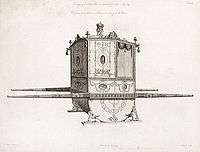
Portuguese and Spanish navigators and colonistics encountered litters of various sorts in India, Mexico, and Peru. They were imported into Spain and spread into France and then Britain. All the names for these devices are ultimately derived from the root sed- in Latin sedere, "sit," which gave rise to seda ("seat") and its diminutive sedula ("little seat"), the latter of which was contracted to sella, the traditional Latin name for a carried chair.[8]

The carried chair met instant success in Europe, whose city streets were often a literal mess of mud and refuse: Where cities and towns did not enjoy the presence of sewage systems left over from Imperial Roman days, it was common to empty chamber pots and discard kitchen refuse from windows down into the adjacent streets. Affluent and well-to-do citizens often found it hazardous and impractical to negotiate those avenues, and sedan chairs allowed them to remain prim and spotless while the carrying valets had to contend with the mud and the filth.
In Europe, Henry VIII of England was carried around in a sedan chair — it took four strong chairmen to carry him towards the end of his life — but the expression "sedan chair" was not used in print until 1615. It does not seem to take its name from the city of Sedan. Trevor Fawcett notes (see link) that British travellers Fynes Moryson (in 1594) and John Evelyn (in 1644-5) remarked on the seggioli of Naples and Genoa, which were chairs for public hire slung from poles and carried on the shoulders of two porters.
From the mid-17th century, visitors taking the waters at Bath would be conveyed in a chair enclosed in baize curtains, especially if they had taken a heated bath and were going straight to bed to sweat. The curtains kept off a possibly fatal draft. These were not the proper sedan chairs "to carry the better sort of people in visits, or if sick or infirmed" (Celia Fiennes). In the 17th and 18th centuries, the chairs stood in the main hall of a well-appointed city residence, where a lady could enter and be carried to her destination without setting foot in a filthy street. The neoclassical sedan chair made for Queen Charlotte remains at Buckingham Palace.
By the mid-17th century, sedans for hire were a common mode of transportation. In London, "chairs" were available for hire in 1634, each assigned a number and the chairmen licensed because the operation was a monopoly of a courtier of Charles I. Sedan chairs could pass in streets too narrow for a carriage and were meant to alleviate the crush of coaches in London streets, an early instance of traffic congestion. A similar system was later used in Scotland. In 1738, a fare system was established for Scottish sedans, and the regulations covering chairmen in Bath are reminiscent of the modern Taxi Commission's rules. A trip within a city cost six pence and a day's rental was four shillings. A sedan was even used as an ambulance in Scotland's Royal Infirmary.
Chairmen moved at a good clip. In Bath they had the right-of-way and pedestrians hearing "By your leave" behind them knew to flatten themselves against walls or railings as the chairmen hustled through. There were often disastrous accidents, upset chairs, and broken glass-paned windows.
Sedan chairs were also used by the wealthy in the cities of colonial America. Benjamin Franklin used a sedan chair late in the 18th century.
Colonial practice
In various colonies, litters of various types were maintained under native traditions, but often adopted by the white colonials as a new ruling and/or socio-economic elite, either for practical reasons (often comfortable modern transport was unavailable, e.g. for lack of decent roads) and/or as a status symbol. During the 17-18th centuries, palanquins (see above) were very popular among European traders in Bengal, so much so that in 1758 an order was issued prohibiting their purchase by certain lower-ranking employees.[9]
The end of a tradition
In Great Britain, in the early 19th century, the public sedan chair began to fall out of use, perhaps because streets were better paved or perhaps because of the rise of the more comfortable, companionable and affordable hackney carriage. In Glasgow, the decline of the sedan chair is illustrated by licensing records which show twenty-seven sedan chairs in 1800, eighteen in 1817, and ten in 1828. During that same period the number of registered hackney carriages in Glasgow rose to one hundred and fifty.
The traveling "silla" of Latin America
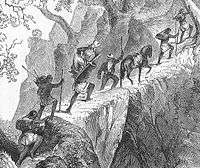
A similar but simpler palanquin was used by the elite in parts of 18th- and 19th-century Latin America. Often simply called a silla (Spanish for seat or chair), it consisted of a simple wooden chair with an attached tumpline. The occupant sat in the chair, which was then affixed to the back of a single porter, with the tumpline supported by his head. The occupant thus faced backwards during travel. This style of palanquin was probably due to the steep terrain and rough or narrow roads unsuitable to European-style sedan chairs. Travellers by silla usually employed a number of porters, who would alternate carrying the occupant. The porters were known as silleros, cargueros or silleteros (sometimes translated as "saddle-men").
A chair borne on the back of a porter, almost identical to the silla, is used in the mountains of China for ferrying older tourists and visitors up and down the mountain paths. One of these mountains where the silla is still used is the Huangshan Mountains of Anhui province in Eastern China.
See also
- Litter (rescue basket)
- Sling (furniture)
- Sedia gestatoria, the portable throne of the popes
- Ark of the Covenant, described in the Hebrew Bible as a portable sacred container and throne of God, sharing similarities with portable shrines and covered sedan chairs
- Howdah (carriage positioned on the back of an elephant or camel)
- Pall-bearer to carry a casket during a funeral procession
References
| Wikimedia Commons has media related to Litters (vehicle). |
- ↑ "Modes of Travelling in China". The Wesleyan Juvenile Offering: A Miscellany of Missionary Information for Young Persons. Wesleyan Missionary Society. X: 102. September 1853. Retrieved 29 February 2016.
- 1 2 3 4 Bath Chronicle (December 2, 2002) Sedan Chairs Ride Again. Page 21.
- 1 2 3 A Hong Kong Sedan Chair, Illustrations of China and Its People, John Thomson 1837–1921, (London, 1873–1874)
- ↑ Tomlin, Jacob Missionary Journals and Letters: Written During Eleven Years' Residence and Travels Amongst the Chinese, Siamese, Javanese, Khassias, and Other Eastern Nations Nisbet: 1844: 384 pages, pp 251:
- ↑ Elsbeth Locher-Scholten, Beverley Jackson, Sumatran sultanate and colonial state: Jambi and the rise of Dutch imperialism, 1830–1907, SEAP Publications, 2004, ISBN 0-87727-736-2, 332 pages
- ↑ Regula Tschumi: The Figurative Palanquins of the Ga. History and Significance. In: African Arts, 46 (4), 2013, S. 60-73.
- ↑ George Balandier "Daily Life in the Kingdom of the Kongo" (1968), p. 117
- ↑ T. Atkinson Jenkins. "Origin of the Word Sedan", Hispanic Review, Vol. 1, No. 3 (July 1933), pp. 240-242.
- ↑ koron
 Tirso López Bardón (1913). "Councils of Braga". In Herbermann, Charles. Catholic Encyclopedia. New York: Robert Appleton Company.
Tirso López Bardón (1913). "Councils of Braga". In Herbermann, Charles. Catholic Encyclopedia. New York: Robert Appleton Company.
Further reading
| Wikisource has the text of the 1911 Encyclopædia Britannica article Litter. |
- Regula Tschumi: Concealed Art. The Figurative Palanquins and Coffins in Ghana. Berne, Edition Till Schaap 2014.
- Regula Tschumi: The Figurative Palanquins of the Ga. History and Significance. In: African Arts, Vol. 46, Nr. 4, 2013, S. 60–73.
- Trevor Fawcett, "Chair transport in Bath": from Bath History, II (1988): richly detailed social history
- Luxury Transport of Palanquins: Historical exhibit at Kamat.com
- Autobiography of palanquin posted by paromita